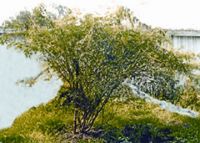Indigo
Indigo (nil) naturally occurring dye stuff obtained from various plants, particularly those of genus Indigofera. They are found to grow wild in India, Central America and China. Indigo is also present in the juices of Isatis tinctoria or woad plant cultivated in Britain. The ancients of Egypt, Greece and Rome knew indigo. Mummies of Egypt's XVIII dynasty (about 1600 BC) were wrapped in indigo-dyed cloth.

About 15 species of Indigofera are found growing in the Bengal region, of which I. tinctoria was cultivated in India for indigo dyes. Indigo occurs in the form of a glucoside, a chemical, that is soluble in water. The best soils for growing indigo plants were those subject to annual inundation by the Ganges, such as Jessore and Krishnanagar, and the Champaran district of Bihar. The indigo plant is a shrub, 1.2-1.8 m high. It flowers during July-September. Flowers are small, the pod is recurved, and racemes are shorter than leaves, while the leaflet is hardly longer than broad.
The preparation of natural indigo is carried out as follows: the plant is cut down, steeped in vats for about 12 hours, and the extract, which is of a greenish colour, is separated and run into fresh vats. Then it is stirred vigorously so as to bring it into contact with atmospheric oxygen.
Insoluble indigo is precipitated as mud, which is collected, pressed, dried, and cut into cubes. Various components other than indigotin are present, the most important being indirubine, or indigo red, indigo green and indigo brown. The indigo plant also has some medicinal value
In the ancient Indian medicinal treatise (Chadak Sanghita) a tribute is paid to the plant. The plant has several ornamental names, such as Nilini, Ranjaini, Graminia, Kalokeshi, Nilpushpa, and Madhupatrika. In modern Ayurvedic treatment, the root and leaf are used for treatment of many maladies. The leaf juice is used against hydrophobia and epilepsy. Indigofera plants are also used as a cover and as green manure for crops.
In Bangladesh indigo was widely cultivated during the early nineteenth century when British planters made large investments in it. The districts where it was widely cultivated were Nadia, Jessore, Bogra, Rangpur and Dhaka. By the late nineteenth century, farmers preferred to cultivate rice and jute since indigo was no more a profit-making crop. When coerced by planters to cultivate indigo, farmers organised a resistance movement during 1859-60. As a result indigo cultivation gradually disappeared from Bengal.
Extinct for more than a century, indigo is now being revived in Bangladesh. Several non-government organisations have undertaken projects to produce high quality indigo, the demand for which is now increasing. In response to environmental hazards, people are now showing more interest in natural dye. Indigo production at present is not yet receiving entrepreneurial response, though its revival attempt has received considerable public interest. [Noazesh Ahmed]
See also indigo resistance movement.
